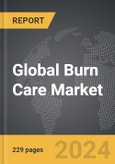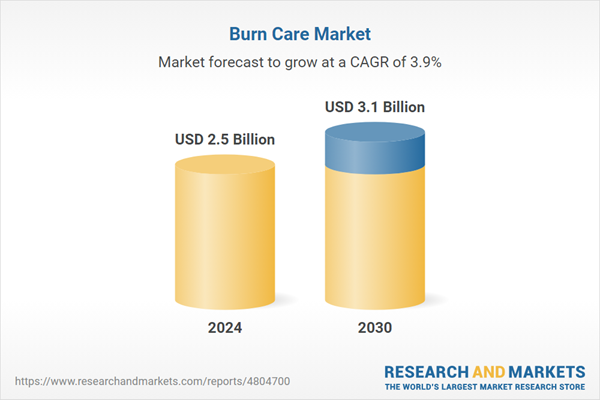Global Burn Care Market - Key Trends and Drivers Summarized
Why Is Burn Care So Critical in Modern Healthcare?
Burn care is an essential and highly specialized field within modern healthcare, but why does it hold such significance? Burns can range from mild injuries to life-threatening conditions, with the potential to cause severe physical and psychological trauma. Burn injuries occur due to various causes, including thermal burns from fire or hot surfaces, chemical burns, electrical burns, and scalds. These injuries can lead to damage not only to the skin but also to deeper tissues, muscles, and bones in more severe cases. Effective burn care is crucial to prevent infections, manage pain, minimize scarring, and ensure proper wound healing. It also plays a vital role in saving lives, especially in cases where burns cover a significant portion of the body. Advances in medical science have significantly improved survival rates for burn victims, but proper treatment requires a multidisciplinary approach, including wound care, fluid resuscitation, pain management, and in some cases, surgery such as skin grafts. The field continues to evolve as new techniques and technologies emerge, ensuring that burn patients receive the best possible outcomes for recovery and rehabilitation.What Are The Different Types and Degrees of Burns That Require Specialized Care?
How do different types and degrees of burns determine the level of care needed? Burns are categorized based on their severity, commonly classified into first, second, and third-degree burns. First-degree burns affect only the outer layer of the skin (epidermis), causing redness and mild pain but generally healing without significant medical intervention. Second-degree burns penetrate deeper into the dermis, leading to blistering, more intense pain, and swelling. These burns require more advanced care to prevent infection and may leave scars. Third-degree burns are the most severe, extending through all layers of the skin and potentially affecting underlying tissues. These burns often destroy nerve endings, resulting in a loss of sensation in the affected area, and they require extensive medical intervention, including surgery, skin grafts, and long-term rehabilitation. Beyond the depth of the burn, the source of the injury - whether thermal, electrical, chemical, or radiation - also influences the treatment approach. For instance, electrical burns may cause internal damage that is not immediately visible on the skin, necessitating thorough medical evaluation and monitoring. Effective burn care is tailored to the type and severity of the burn, with the goal of promoting healing, preventing complications, and reducing long-term physical and psychological impact.How Has Technology and Innovation Transformed Burn Care Treatment?
The treatment of burn injuries has evolved remarkably over the years due to advances in technology and medical innovation. But what are the specific innovations shaping modern burn care? One of the most significant breakthroughs is the development of skin substitutes and bioengineered skin grafts, which have revolutionized how severe burns are treated. Traditional skin grafts, often harvested from the patient's own body, can be painful and limited by the availability of healthy donor skin. Bioengineered skin, on the other hand, allows for the creation of artificial skin layers that can be used to cover large wounds, promoting faster healing and reducing the need for multiple surgeries. Another key area of innovation is in wound care products, including advanced dressings that create an optimal environment for healing, prevent infection, and manage moisture levels. Hydrogels, antimicrobial dressings, and negative pressure wound therapy (NPWT) have all played a part in improving patient outcomes. Additionally, advancements in pain management techniques, such as the use of topical anesthetics and more effective pain relief medications, have significantly enhanced the comfort of burn patients during recovery. Digital tools, including telemedicine and electronic health records, are also helping to streamline burn care by improving patient monitoring, communication between healthcare teams, and access to specialized care. The combination of these innovations has dramatically transformed burn care, making treatment more effective, less painful, and tailored to the specific needs of each patient.What Are the Major Growth Drivers in the Burn Care Market?
The growth in the burn care market is driven by several factors, reflecting advancements in medical technology, changing patient needs, and the increasing incidence of burn injuries. One of the main drivers is the rising number of burn cases worldwide, particularly in regions where safety standards are lacking or where populations are more exposed to fire hazards, chemicals, and electrical sources. Industrial accidents, domestic burns, and fire-related injuries contribute significantly to the demand for specialized burn care. Additionally, advancements in medical treatments, including bioengineered skin substitutes, skin grafting techniques, and advanced wound care products, are fueling the market as hospitals and burn centers adopt these cutting-edge technologies. Increased awareness of the importance of early intervention and specialized treatment for burns has also led to a greater demand for comprehensive care, particularly in urban areas with well-established healthcare systems. The growing focus on improving healthcare infrastructure in developing countries is another factor contributing to market expansion, as these regions invest in burn care facilities and modern treatment options. Furthermore, rising healthcare expenditure and the increasing availability of health insurance coverage are making advanced burn care more accessible to a broader population. As medical innovation continues and the global burden of burn injuries remains high, the burn care market is expected to see continued growth in response to these multifaceted drivers.Report Scope
The report analyzes the Burn Care market, presented in terms of market value (USD). The analysis covers the key segments and geographic regions outlined below.- Segments: Product Type (Advanced Burn Care, Traditional, Biologics); Depth (Partial-Thickness Burn, Minor Burn, Full-Thickness Burn); End-Use (Hospitals, Physician Clinics, Homecare).
- Geographic Regions/Countries: World; United States; Canada; Japan; China; Europe (France; Germany; Italy; United Kingdom; Spain; Russia; and Rest of Europe); Asia-Pacific (Australia; India; South Korea; and Rest of Asia-Pacific); Latin America (Argentina; Brazil; Mexico; and Rest of Latin America); Middle East (Iran; Israel; Saudi Arabia; United Arab Emirates; and Rest of Middle East); and Africa.
Key Insights:
- Market Growth: Understand the significant growth trajectory of the Advanced Burn Care segment, which is expected to reach US$1.5 Billion by 2030 with a CAGR of 3.9%. The Traditional segment is also set to grow at 3.3% CAGR over the analysis period.
- Regional Analysis: Gain insights into the U.S. market, valued at $666 Million in 2024, and China, forecasted to grow at an impressive 6.8% CAGR to reach $659.2 Million by 2030. Discover growth trends in other key regions, including Japan, Canada, Germany, and the Asia-Pacific.
Why You Should Buy This Report:
- Detailed Market Analysis: Access a thorough analysis of the Global Burn Care Market, covering all major geographic regions and market segments.
- Competitive Insights: Get an overview of the competitive landscape, including the market presence of major players across different geographies.
- Future Trends and Drivers: Understand the key trends and drivers shaping the future of the Global Burn Care Market.
- Actionable Insights: Benefit from actionable insights that can help you identify new revenue opportunities and make strategic business decisions.
Key Questions Answered:
- How is the Global Burn Care Market expected to evolve by 2030?
- What are the main drivers and restraints affecting the market?
- Which market segments will grow the most over the forecast period?
- How will market shares for different regions and segments change by 2030?
- Who are the leading players in the market, and what are their prospects?
Report Features:
- Comprehensive Market Data: Independent analysis of annual sales and market forecasts in US$ Million from 2024 to 2030.
- In-Depth Regional Analysis: Detailed insights into key markets, including the U.S., China, Japan, Canada, Europe, Asia-Pacific, Latin America, Middle East, and Africa.
- Company Profiles: Coverage of players such as 3M Company, Acelity LP, Inc., Coloplast A/S, Derma Sciences, Inc., DeRoyal Industries, Inc. and more.
- Complimentary Updates: Receive free report updates for one year to keep you informed of the latest market developments.
Some of the 12 companies featured in this Burn Care market report include:
- 3M Company
- Acelity LP, Inc.
- Coloplast A/S
- Derma Sciences, Inc.
- DeRoyal Industries, Inc.
- Hollister, Inc.
- Medtronic PLC
- Molnlycke Health Care
- Smith & Nephew PLC
This edition integrates the latest global trade and economic shifts into comprehensive market analysis. Key updates include:
- Tariff and Trade Impact: Insights into global tariff negotiations across 180+ countries, with analysis of supply chain turbulence, sourcing disruptions, and geographic realignment. Special focus on 2025 as a pivotal year for trade tensions, including updated perspectives on the Trump-era tariffs.
- Adjusted Forecasts and Analytics: Revised global and regional market forecasts through 2030, incorporating tariff effects, economic uncertainty, and structural changes in globalization. Includes historical analysis from 2015 to 2023.
- Strategic Market Dynamics: Evaluation of revised market prospects, regional outlooks, and key economic indicators such as population and urbanization trends.
- Innovation & Technology Trends: Latest developments in product and process innovation, emerging technologies, and key industry drivers shaping the competitive landscape.
- Competitive Intelligence: Updated global market share estimates for 2025, competitive positioning of major players (Strong/Active/Niche/Trivial), and refined focus on leading global brands and core players.
- Expert Insight & Commentary: Strategic analysis from economists, trade experts, and domain specialists to contextualize market shifts and identify emerging opportunities.
Table of Contents
Companies Mentioned (Partial List)
A selection of companies mentioned in this report includes, but is not limited to:
- 3M Company
- Acelity LP, Inc.
- Coloplast A/S
- Derma Sciences, Inc.
- DeRoyal Industries, Inc.
- Hollister, Inc.
- Medtronic PLC
- Molnlycke Health Care
- Smith & Nephew PLC
Table Information
| Report Attribute | Details |
|---|---|
| No. of Pages | 229 |
| Published | December 2025 |
| Forecast Period | 2024 - 2030 |
| Estimated Market Value ( USD | $ 2.5 Billion |
| Forecasted Market Value ( USD | $ 3.1 Billion |
| Compound Annual Growth Rate | 3.9% |
| Regions Covered | Global |









